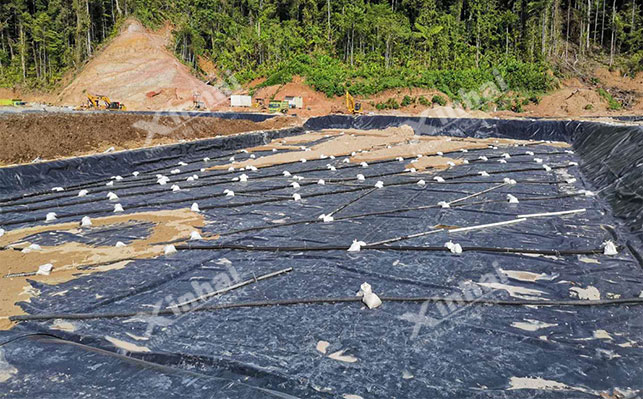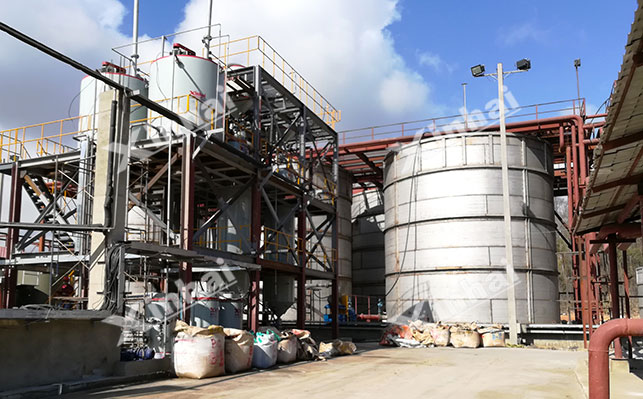
15311826613
Click to add WeChatWith the increasing scarcity of gold resources, oxidized gold ore has become a primary development target for investors. Because oxidized gold ore is a special type of gold ore formed under supergene geological processes, its gold occurrence is complex and its ore properties are unique, making gold extraction relatively difficult. This article will introduce the properties of oxidized gold ore and several common gold extraction technologies.
The characteristics of oxidized gold ore originate from the "supergene oxidation" process. This involves the long-term weathering of primary sulfide gold ore, where sulfides are oxidized to iron oxides, exposing gold particles or causing them to coexist with oxides. Simultaneously, this is accompanied by the enrichment of clay minerals, forming the typical characteristics of "high clay content, polarized gold particle distribution, and low sulfide content."

High mud content: The mud content of gold oxide ore is usually between 15% and 40%, and in some cases even it can reach over 50%. This mud mainly comes from clay minerals and iron oxide clay, which have strong water absorption and dispersibility. When it comes into contact with water, it easily expands to form mud clumps, clogging the ore pores and thus reducing the permeability of the ore pile. In addition, the surface of the mud is negatively charged, which will adsorb cyanide and gold cyanide complex ions, increasing reagent consumption.
Polarized Gold Grain Distribution: Coarse-grained gold (>0.1 mm) and fine-grained gold coexist. Coarse-grained gold accounts for 10%-30%, mostly secondary enrichment of free gold during oxidation, which is easily recovered and can be pre-selected before leaching. Fine-grained gold (<0.01 mm) accounts for as much as 70%-90%, and some is encapsulated by other minerals, requiring disruption of the mineral structure for exposure.
Low Sulfide Content: Sulfide content in oxidized gold ores is typically<5%, and mostly consists of iron oxides. Although direct cyanide leaching is possible, gold easily forms "gold-iron oxide complexes" with iron oxides, increasing reagent consumption. Furthermore, Fe³⁺ combines with CN⁻ to form Fe(CN)₆³⁻, interfering with gold dissolution and adsorption.
The slurry properties fluctuate greatly: Oxidized ores contain a large amount of soluble salts and acidic minerals, resulting in highly unstable properties. pH values are prone to fluctuation, and high concentrations of Fe³⁺ oxidize the surface of gold particles, forming a passivation film that hinders the reaction between gold and cyanide.
In response to the characteristics of oxidized gold ores, the industry has developed a technical system centered on "leaching," combined with pretreatment and enhanced adsorption. Different methods have different focuses in terms of applicable scenarios and process details.

Heap leaching for gold utilizes gravity to allow the leaching solution to permeate the ore heap, dissolving the gold for recovery. It is suitable for processing cost-sensitive ores with good permeability. When the clay content is high...
Pelletization heap leaching for gold involves adding a binder to granulate the clayey ore, thereby improving its permeability and mitigating clogging. Typically, oxidized ores with a mud content of 20%-40% are crushed to -10mm, then 3%-5% cement binder and 0.5%-1% lime are added to adjust the pH. The ores are then granulated into 3-10mm particles using a rotary drum granulator, creating porosity between the particles to enhance permeability. These are then piled into 10-12m heaps for spraying and leaching, with a leaching cycle of approximately 40-70 days.

Carbon leaching for gold involves directly feeding the product from grinding into a leaching tank to simultaneously complete cyanide dissolution and activated carbon adsorption. This method effectively avoids the adsorption of gold ions by fine mud and is suitable for ores with high mud content and predominantly fine-grained gold.
Before feeding the leaching tank, the ore needs to be finely ground to 70%-80% of particles smaller than 0.074mm, ensuring a pulp concentration of 30%-40%. Leaching is performed in 5-8 tanks connected in series. Sodium cyanide and lime are added first to adjust the pH to 10-11 to dissolve the gold. Then activated carbon is added, allowing the gold-cyanide complex ions to be adsorbed by the activated carbon to form gold-loaded carbon. Electrolysis is then performed to obtain gold mud, and the activated carbon is regenerated and recycled. This method is suitable for gold extraction from oxide gold ores with a mud content >30% and a fine gold particle content >80%.
The resin pulp method is a low-cyanide, highly selective, and environmentally friendly gold extraction method. It mainly uses ion exchange resin instead of activated carbon, utilizing the high selective adsorption of gold-cyanide complex ions by the resin to reduce the amount of cyanide used. It is suitable for areas with high environmental protection requirements. Typically, after grinding to a certain fineness, cyanide leaching is performed. A strongly basic anion exchange resin is added to the slurry, and the gold-loaded resin is desorbed using dilute acid after adsorption. This method is suitable for oxidized ores with a mud content of 25%-40% and many associated impurities.
The bio-oxidation pretreatment + cyanide method is mainly for ores that are partially incompletely oxidized and contain small amounts of residual sulfides. Bacteria oxidize the sulfides, exposing the gold inclusions, followed by cyanide leaching. This method is suitable for semi-oxidized ores containing arsenic and sulfur. Typically, *Thiobacillus ferrooxidans* is used, oxidizing arsenopyrite to Fe³⁺ and AsO₄³⁻ at pH 2.0-2.5 and a temperature of 30-35℃ for 5-7 days. After oxidation, the slurry is adjusted to pH 10-11, and gold is leached by cyanide.

The roasting oxidation method mainly involves high-temperature roasting to oxidize and decompose residual sulfides, breaking down gold inclusions. Typically, roasting is carried out in a rotary kiln at 800℃ for 2-3 hours, oxidizing pyrite to Fe₂O₃ and SO₂; and oxidizing arsenopyrite to Fe₂O₃ and As₂O₃. Leaching is then performed, and cyanide leaching can increase the gold recovery rate to over 80%. This method is particularly suitable for difficult-to-leach ores with high sulfur and high arsenic content.
The key to selecting gold extraction methods from oxide gold ores is to follow the principle of ore characteristics-process suitability, focusing on three core aspects: mud content, gold grain distribution, and impurity content.
1. When the mud content is<20% and coarse-grained gold is predominant, heap leaching is preferred. This is mainly because oxide gold contains little mud and is mostly sandy ore, allowing for smooth penetration of the mineral leachate. Uniform leaching can be achieved without complex pretreatment, and the cost is relatively low.
2. When the mud content is between 20% and 40% and fine-grained gold is predominant, granulation heap leaching or carbon leaching can be selected. The former is more suitable for low- to medium-grade oxide gold ores; the latter is more suitable for high-grade oxide gold ores.
3. When the mud content is >40% and environmental protection requirements are stringent, the resin slurry process can be chosen. This is mainly because ion exchange resins are more tolerant of fine mud and require less cyanide, about 30% less than the carbon leaching method.
4. When the sulfur or arsenic content is >3%, the biological oxidation or roasting method is often used. The former is suitable for processing low-sulfur, low-arsenic oxide gold ores; the latter is suitable for high-sulfur, high-arsenic oxide gold ores.
In summary, the key to gold extraction from oxide gold ores is to specifically address the dual challenges of high mud content and fine-grained gold. Only through accurate analysis of ore characteristics and process adaptation can a balance between cost and recovery rate be achieved. In gold extraction, Xinhai Mining Equipment boasts over 30 years of experience, capable of tailoring beneficiation process solutions for each mine. From experimental research to stable production, the entire process—from blueprints to commissioning—is seamlessly integrated, with each step tightly controlled to ensure faster and better production targets. In gold ore beneficiation alone, they offer 29 innovative process technologies.
Xinhai Equipment has over 30 years of experience in gold extraction, capable of tailoring beneficiation process solutions for each mine.